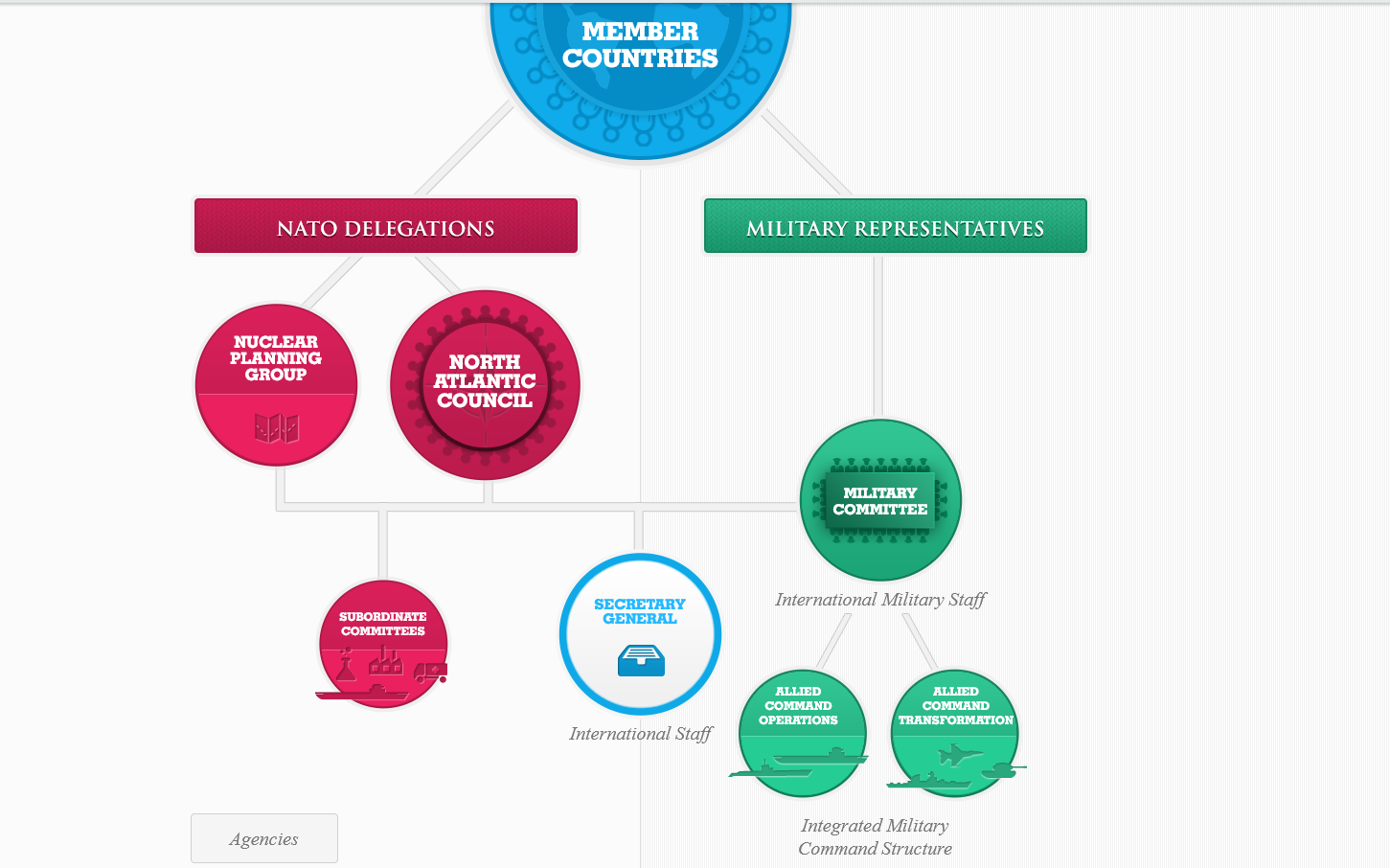Structure of NATO
North Atlantic Treaty Organisation has civilian-military structure. This structure reflects combination of military and political responsibility of NATO.
 Source: www.nato.int Source: www.nato.int |
Political elements of structure
- The North Atlantic Council (NAC) - the main body with executive political and decision-making authority. It meets twice a year for the spring and autumn sessions at the level of ministers of foreign affairs and prime ministers. Between ministerial sessions, it meets at least once a week at the level of permanent representatives of all member countries in the rank of ambassadors. The decisions are equally binding regardless of the level of the participating state representatives. Decisions are made on the basis of consensus, that is, every decision must be approved on the basis of unanimity and general agreement.
- The Defence Policy and Planning Committee (DPPC) - it serves primarily for the analysis of the defense expenditures of the member states and for the coordination of military planning, armed forces and armaments. It meets regularly at the level of permanent representatives and twice a year at the level of ministers of defense. Within its competences, it has the same powers as the North Atlantic Council.
- The Nuclear Planning Committee (NPG) -the core forum that consults on all issues related to the role of nuclear forces in NATO's security and defense policy. It meets twice a year at the level of defense ministers, usually together with the Defense Planning Committee.
- The Secretary General - the highest political international representative of NATO and the chairman of the North Atlantic Council, the Defense Planning Committee and the Nuclear Planning Group. He manages the international secretariat, he is the main spokesman of the Alliance in communication with the representatives of the governments of the member countries. He is responsible for the consultation and decision-making process.
- The International Secretariat - serves the Council and a wide range of committees and working groups dealing with policy matters, defense planning, defense assurance, infrastructure and logistics, scientific research and the environment.
|
| |
|
 |
Military elements of structure
- The Military Committee (MC) - the highest military body of the Alliance under the political authority of the North Atlantic Council and the Defense Planning Committee, or Nuclear Planning Groups. It consists of the chiefs of staff of all member countries, which are represented by the military mission in the Military Committee. The Chiefs of Staff meet at least twice a year.
- The International Military Staff (IMS) - an integrated military staff that assists the NATO Military Committee in solving specific military issues. It fulfills the decisions of the Military Committee, prepares studies and plans for the procedure proposed by the national authorities of member countries or NATO authorities.
- Allied Command Operations (ACO) -based in Belgium near the city of Mons, it is responsible for the area of planning and implementation of joint operations of the allied military forces to achieve the political goals of the Alliance.
- Allied Command Transformation (ACT) - is responsible for supporting and overseeing the transformation of allied forces and capabilities based in Norfolk, USA.
|
 |
Parliamentary and nongovernmental organizations
- NATO Parliamentary Assembly (NATO PA) - an institution that has been acting as an inter-parliamentary forum of member countries since 1955. Members of Parliament are nominated by national parliaments according to their standard procedures and on the basis of party representation. It has 188 regular members. The number of members in the delegations of individual countries is determined according to the population. It is completely independent from NATO and represents a wide spectrum of political opinions. It meets twice a year in a plenary session, which is held successively in the capitals of member countries. Headquarters of the Secretariat: Brussels
- Atlantic Treaty Association (ATA) -non-governmental organization made up of voluntary national organizations (Atlantic commissions, associations) of individual member countries. Existing organizations in partner countries have the status of associate members. The main goal of the activities of national organizations is to support NATO and the main goals of the North Atlantic Treaty. Headquarters: Brussels
|
Last update: Updated 15.04.2024 15:20 Print Page Up
 Source: www.nato.int
Source: www.nato.int